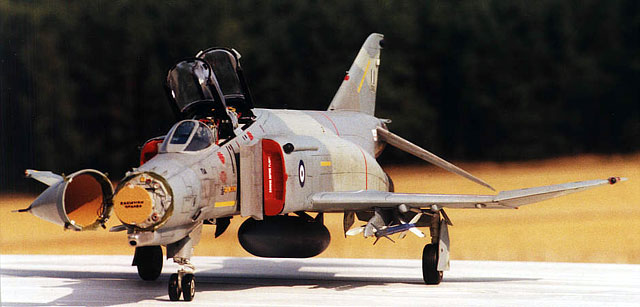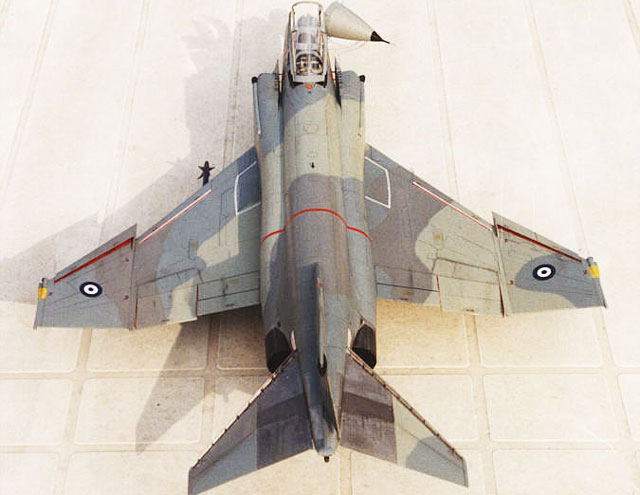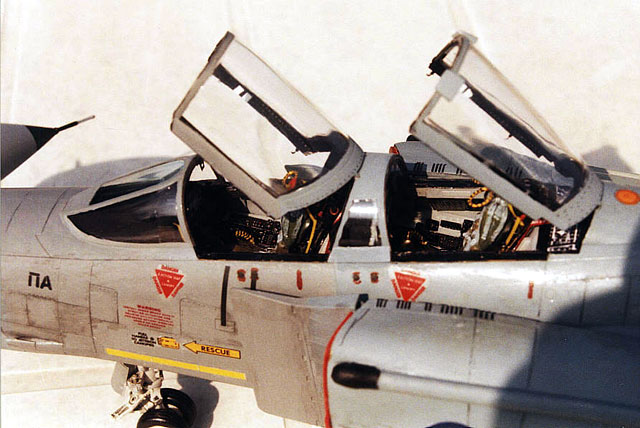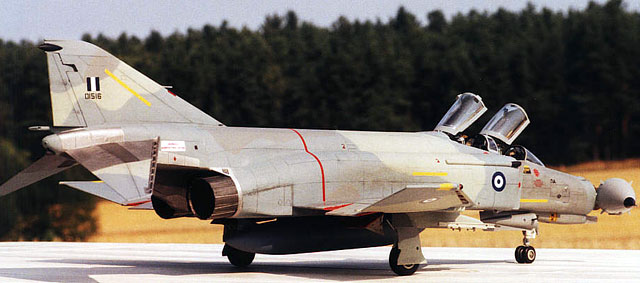|
The F-4E in Hellenic Air Force
Service - Part II
by Dr. Menelaos Skourtopoulos
|

|
|
McDonnell-Douglas F-4E Phantom II |
Peace Icarus Phantom II in 1/32 Scale

HyperScale is proudly supported by Squadron
This is the second instalment of the story about
the F/RF-4E service in the Hellenic Air Force from the mid 70es until
today, a story that is most interesting concerning the colours and the
technical diversity that carried by the Hellenic Phantoms.
Greece received 58 new F-4Es between 1974 and 1978.
They had following serials:
72-1500-72-1535
74-1618-74-1619
77-1743-77-1760
77-0357-77-0358
In 1997 the Hellenic Aerospace Industries (EAB) started together with DASA
in Germany an update Program for the modernisation of 39 F-4Es, to make
them flyable until 2018. These aircraft were all from the new F-4E batches
received in the 70es, because they were in a much better condition as the
other F-4s received between 1992 and 1993 from the US National Guard. This
project called Peace Icarus 2000 (I and II) and included a new radar
(APG-65), new color multi function cockpit screens, AMRAAM and AIM-9M
capability, AFDS, advanced friend/foe identification, and many more
changes that based partially on the F-4F ICE program.
The Peace Icarus I batch (28 aircraft) includes
aircraft from the serial no. 72-1500 through 72-1535 with the 72-1523
served as the prototype. This aircraft was updated in Manching-Germany and
nicknamed “Princess of Andravida” (Andravida is the home AB of the 338 and
339 F-4E Sqs in Greece).

The Peace Icarus II batch ( 11 aircraft) includes
aircraft of the second order in 1976 with serial no: 77-1743 through
77-1760 with 77-1760 serving as the prototype. The rest of the aircraft
updated in Greece.
The Peace Icarus F-4s had lost their original AIM-7 capability due to the
new electronics and the launcher, which was made to fire only the AIM-120.
Further differences to the German F-4F ICE is the air to ground capability
of the Peace Icarus F-4E, the IFF, and the cockpit configuration.
The program is now finished and the Peace Icarus
2000 Phantom is a very dangerous adversary even for the newer and more
advanced “electric” jets of today.
Building the
Peace Icarus Phantom II
|
As I saw the first pictures of the cockpit of the
Peace Icarus Phantom, I thought, that it will be a nice opportunity and
challenge to make a model of such an aircraft.
I used once again the Revell 1:32 F-4F kit. It’s a
very good kit with fine recessed panel lines and many detailed corners,
but the kit has also its problems:
First of all you’ll find the APG-65 Radar in the
kit. It’s nicely made and you MUST cut the nose to show it, if you want to
make either a German ICE or a Hellenic PI Phantom. The kit also includes
3D instrumentation in the cockpits, the F-15 style centerline tank, four
AIM-120 AMRAAMs and many more details. And the problems? Well, here they
are!:
-
The cockpits are in the
normal configuration and I had to change them.
-
The F-4F has no slotted
stabilators and I had to order them from Revell/Monogram (thanks guys!).
The upper part of the fin (part no. 208) is not
correct and I had to rework it (in the F-4E kit you’ll find the right
one!)
I also had to build some other parts that they are
only on the Peace Icarus Phantom to see, but they were easily made from
scratch.
Cockpits
As I wrote above, the new F-4E has almost totally
changed instrument panels. I was glad to have some detail pics of the new
cockpits, so I made them almost from scratch.
The front panel is not the same anymore and has a
color multifunction screen on the top left side and the old APQ-120 radar
scope is gone. I used the Eduard photoetched kits to make things better. I
cut the area where the screen is, and I made that screen from a piece of
resin covered with sheet styrene of Evergreen. The screen is overall black
with dark green front and light gray knobs. A new HUD was done from sheet
styrene and clear plastic sheet. The old radar screen was removed and a
new panel made from sheet styrene and covered with a decal sheet, that I
found in Tamiyas F-14 in 1/32 scale, took its place now.
I had to made the hole WSO front panel from scratch. The two screens made
in the same way as for the front cockpit. I used many instruments from the
F-4F kit. I just cut them away from the original panel and glue them in
their new position on a new panel made from sheet styrene. I also added
some cables in its back to simulate the typical F-4 ... cable chaos there.

Click the thumbnaile below
The back cockpit is too deep, so I had to cut it
away from the front and back wall, and glue it again 0.5cm higher. If you
don’t change it, you’ll have to put the seat much higher and it doesn’t
look right ... otherwise the situation in the cockpits is OK.
The seats that I found in the F-4F kit are very
good, but I changed them with resin ones from CAM. I used only the face
curtains handles from the kit. If you use them it’s better to change the
harness and buckles on them (the Eduard sets 32-032 and 32-024 are just
fine for that purpose). I put two REMOVE BEFORE FLIGHT in the area behind
the seats, and a yellow band for the safety pins on each seat.
I also had to make some work inside the canopies. I used sheet styrene and
putty to represent the structure of the front and the back canopies and
the Eduard sets to represent the canopy rails.
Radar
The kit gives the APG-65 antenna which is just
fine. I didn’t add any other extra detail parts except some cables that
going inside the open radome and the open locking clips of the radome. I
also printed the “RADIATION HAZARD” on transparent decal sheet.

Undersides
One more problem showed up here. The front landing
gear is out of scale being too thin!. I had to make the hole thing from
scratch for all F/RF-4s in this series (I used photos from the real thing
and the same part from the Tamiya kit as a template), but for the Peace
Icarus Phantom I used the Tamiya part. Sadly enough, that kit is broken
badly last year while I moved to another town and I had to cannibalize it
and use its parts to make the other F-4s looking better. The main
undercarriage is otherwise well done from Revell. I took also the wheels
from the Tamiya kit (sorry guys..!)
I used only the F-15 style centerline tank (you
have also the option for the original tank!) and no wing tanks.
The Sidewinder rails from the Tamiya kit made
things better in the area.
I had to open the bleed air doors under the
fuselage between the centerline tank (do it before you glue the fuselage
halves with the wing) and glue them in the open position.
More...
The PE Phantom has four small IFF antennas in the
front part of the nose (just like those on the F-16C) and four antennas of
the DIAS self protection system that carried since 1984 on the majority of
the Hellenic Phantoms in four positions: under the radome, on the left and
right air intake (just like those found on the F-4N), and under the drag
chute cover. I made them from sprue styrene and putty.
The nozzles of the J-79-17 engines are partially
good, and if you want a perfect result, you have to add some more details
inside them. This means more extra kits and more money and .... well, I
thought I could live with them! The only thing I worked here was to make
the afterburner deeper using the parts from the Tamiya F-4.
The FODs are from Reheat, but only for the Tamiya
F-4 and they are a little bit smaller and I had to use some putty to make
them looking better. I put once again two REMOVE BEFORE FLIGHT on the FODs.
The painting schemes found on Hellenic Phantoms
varied from the standard US SEA scheme to the new Ghost scheme. The Aegean
blue scheme was used until the recent days and it is been replaced now
with the new ghost scheme seen on the F-16C/Ds and F-5A/Bs. You need four
colors to represent the ghost scheme: Blue gray FS 35237 , gray FS 36251,
gray FS 36307, and gray FS 36320 for the radome. I used enamels from
Humbrol (145, 140, 141, 128).
You can find the paint scheme at the following web
link:
http://www.jpsmodell.de/dc/shemes/f4e_greek2.jpg
I didn’t used a spray gun to paint the model. Once again everything is
made by brush.

Some of the decals were made by drawing and
printing them on clear decal sheet. The Greek roundels are made in Greece
from Plastimodellismo. They are now smaller on the Greek F-4s for low
visibility reasons…
In the part III we will take a look at the RF-4E’s of the HAF, so.... stay
tuned!!
-
Ptisi & Diastima Vol 168/
178/ 185
-
Modelling Magazine Vol
72/ 73
-
F-4 Phantom ( Kostas
Dimitropoulos) (Costandinidis Publications)
-
Machitika Aeroskafi
Polemikis Aeroporias (Combat Aircraft of the (Hellenic) Air Force) (in
Greek) published from the Model magazine „Modelling“
-
F-4 Phantom II in detail
and scale (Part 2, 1, 3)(Bert Kinzey)
Click the
thumbnails below to view larger images:
Model, Images and Text Copyright ©
2003 by Dr. Menelaos Skourtopoulos
Page Created 05 October, 2003
Last Updated
17 March, 2004
Back to
HyperScale Main Page |
Home |
What's New |
Features |
Gallery |
Reviews |
Reference |
Forum |
Search